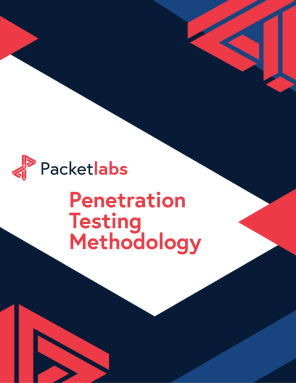A Comprehensive Guide to Mobile Penetration Testing
- This Guide Includes
- Who Will Benefit From This Guide
- What is Mobile Penetration Testing?
- Why Mobile Penetration Testing is Essential
- Benefits of Mobile Pentesting Include:
- Packetlabs Mobile Penetration Testing Methodology
- Our methodology covers:
- What Makes Mobile Pentesting Different
- Regulatory and Compliance Alignment Via Mobile Penetration Testing
- Why Choose Packetlabs
- What Does a Mobile Pentest Report Include?
- Next Steps
Would you like to learn more?
Download our Pentest Sourcing Guide to learn everything you need to know to successfully plan, scope, and execute your penetration testing projects.
Your customers now live on their phones. Payments, healthcare, identity, and work all flow through mobile apps... and threat actors know it. A single insecure API call, a leaky WebView, or a hard-coded secret can become a front door to your brand, your data, and your users.
Mobile Penetration Testing validates the real-world security of your iOS and Android apps, from the code and device controls to the APIs and cloud backends that power them. Done right, it protects revenue, privacy, and trust before attackers test them for you.
This guide explains what mobile pentesting entails, how it differs from traditional web or infrastructure testing, and how Packetlabs’ Mobile Penetration Testing methodology helps you ship secure apps faster.
This Guide Includes
A comprehensive overview of Mobile Penetration Testing
Why mobile security is critical to digital resilience
The phases and methodologies behind a mobile pentest
How mobile pentesting differs from other assessments
How mobile testing supports regulatory and compliance initiatives
What to expect from a Packetlabs Mobile Pentest engagement
Next steps for teams ready to secure their mobile apps
Who Will Benefit From This Guide
CISOs, CTOs, and product leaders responsible for mobile channels
Mobile engineers and DevSecOps teams shipping iOS/Android apps
Security architects and administrators supporting mobile programs
MSPs, SaaS vendors, and fintech/healthtech platforms with mobile fronts
Compliance officers and cyber insurance stakeholders seeking verified assurance
What is Mobile Penetration Testing?
Mobile Penetration Testing is a specialized security assessment for iOS and Android applications and their supporting services. It combines static analysis (SAST), dynamic analysis (DAST), and manual exploitation to identify issues across:
App binaries & code paths (e.g., insecure storage, weak crypto, hard-coded secrets)
Runtime protections (root/jailbreak detection, anti-tamper, obfuscation)
App-to-API communication (auth, session management, TLS, cert pinning)
Platform integrations (Intents/Deep Links/URL Schemes, Keychain/Keystore, Face/Touch ID)
Embedded browsers & WebViews (XSS, origin policy, unsafe bridges)
Third-party SDKs & supply chain (analytics, ads, payment, SSO)
A comprehensive mobile pentest delivers:
Clear identification of exploitable vulnerabilities and misconfigurations
Verification of authentication, authorization, and session controls
Evidence of data exposure risks on-device and in transit
Actionable remediation mapped to business impact and release cycles
Why Mobile Penetration Testing is Essential
Mobile apps are the front line for both growth and fraud. Threat actors target mobile to:
Exfiltrate PII and payment data via weak storage or verbose logs
Bypass authentication (abusing OAuth/JWT, SSO flows, or session replay)
Abuse business logic (coupon/points fraud, transaction manipulation)
Exploit platform features (deep link hijacking, intent injection, insecure WebViews)
Reverse engineer apps to clone features, harvest secrets, or disable controls
Regular mobile pentesting ensures you find and fix these weaknesses before they translate into breaches, churn, or fines.
Benefits of Mobile Pentesting Include:
Protecting customer data, brand reputation, and revenue
Reducing fraud and account-takeover risk
Validating TLS, certificate pinning, token lifecycles, and MFA
Supporting OWASP MASVS/MASTG, OWASP ASVS, ISO 27001, SOC 2, GDPR, HIPAA, and PCI DSS
Strengthening trust with users, partners, and app store reviewers
Packetlabs Mobile Penetration Testing Methodology
Every engagement is tailored to your app architecture, risk profile, and release cadence to protect against the top mobile app threats.
Our assessments are 100% manual, production-safe, and executed by certified ethical hackers with deep iOS/Android expertise.
Our methodology covers:
Discovery and Threat Modelling
Map app features, data flows, and third-party SDKs
Identify high-risk use cases (payments, healthcare, identity)
Static and Build Analysis (SAST)
Review app binandries/IPA/APK for secrets, insecure crypto, debug artifacts
Assess build configs (ProGuard/obfuscation, ATS/Network Security Config)
Dynamic Analysis (DAST) and Runtime Protections
Exercise the app on real devices/emulators; inspect traffic, tokens, headers
Evaluate jailbreak/root detection, anti-tamper, and re-packaging resilience
Auth, Session and API Security
Test OAuth/OIDC, JWT, token rotation, refresh flows, logout/invalidate
Validate server-side authorization and rate-limit/abuse controls
Assess TLS versions, cipher suites, and certificate pinning robustness
Platform and UX Attack Surface
Deep Links/URL Schemes/Intents: hijacking, parameter tampering, forced navigation
WebViews: JavaScript bridges, origin policy, XSS, navigation controls
Keychain/Keystore: secure storage, biometrics, local auth flows
Data Exposure and Privacy
On-device storage, logs, backups, notifications, screenshots/app switcher
Clipboard, inter-app communication, screenshots caching, and crash reporting
Abuse and Business Logic
Transaction replay, coupon/points abuse, price/quantity manipulation
Abuse of background tasks, push tokens, and offline modes
Post-Exploitation and Chaining
Demonstrate end-to-end attack paths (device → API → account takeover)
Validate detection/response and provide prioritized fixes
All testing aligns with the OWASP Mobile Application Security Verification Standard (MASVS) and the Mobile Application Security Testing Guide (MASTG), plus OWASP ASVS for API/backend alignment.
What Makes Mobile Pentesting Different
Mobile security isn't just web testing on a smaller screen. It blends application, platform, and hardware concerns to encompass:
On-device realities: storage, logs, biometrics, Keychain/Keystore nuances
Platform features: deep links, intents, app extensions, push services
Reverse engineering and tamper resistance: obfuscation, anti-debug, packers
API coupling: mobile clients drive high-risk API flows and token lifecycles
App-store expectations: review guidelines and privacy disclosures
Regulatory and Compliance Alignment Via Mobile Penetration Testing
Mobile Penetration Testing supports:
OWASP MASVS/MASTG, OWASP ASVS
ISO 27001 / ISO 27701, SOC 2
GDPR / HIPAA (privacy & PHI handling)
PCI DSS v4.0 (mobile payment flows and data protection)
Routine testing demonstrates due diligence, strengthens cyber-insurance posture, and reduces risk from third-party SDKs and integrations.
Why Choose Packetlabs
Packetlabs is a global leader in advanced penetration testing across mobile, web, cloud, and enterprise.
Why clients choose us:
Every tester holds OSCP at minimum, with the majority also holding OSWE, OSEP, and GXPN certifications
Testing is performed 100% in-house with no outsourcing, guaranteeing consistent quality
Clients rate Packetlabs 9.5/10 for clarity, depth, and professionalism
We provide clear remediation guidance and collaborative post-test support
Our consultative approach goes beyond finding issues: we help your teams secure thoroughly, quickly.
What Does a Mobile Pentest Report Include?
Every Packetlabs Mobile Penetration Test includes:
A prioritized report detailing vulnerabilities, impact, and exploit paths
Executive summary for leadership and non-technical stakeholders
Technical evidence (request/response pairs, screenshots, PoC steps)
Actionable, risk-ranked remediation guidance mapped to MASVS/MASTG
Optional post-remediation retesting to verify fixes
Next Steps
If your organization ships or relies on iOS or Android apps, now is the time to assess and harden your mobile security.
Connect with our team of experts to:
Review your current mobile risk profile
Define a tailored testing scope and schedule
Start protecting your users (and your brand) where and when it matters most
Contact Us
Speak with an Account Executive
Interested in Pentesting?

Penetration Testing Methodology
Our Penetration Security Testing methodology is derived from the SANS Pentest Methodology, the MITRE ATT&CK framework, and the NIST SP800-115 to uncover security gaps.
Download Methodology
Pentest Sourcing Guide
Download our Pentest Sourcing Guide to learn everything you need to know to successfully plan, scope, and execute your penetration testing projects.
Download GuideExplore in-depth resources from our ethical hackers to assist you and your team’s cyber-related decisions.

September 13 - Blog
Why Multi-Factor Authentication is Not Enough
Knowing is half the battle, and the use and abuse of common frameworks shed insight into what defenders need to do to build defense in depth.

November 19 - Blog
The Top Cybersecurity Statistics for 2024
The top cybersecurity statistics for 2024 can help inform your organization's security strategies for 2025 and beyond. Learn more today.

October 24 - Blog
Packetlabs at SecTor 2024
Packetlabs is thrilled to have been a part of SecTor 2024. Learn more about our top takeaway's from this year's Black Hat event.







